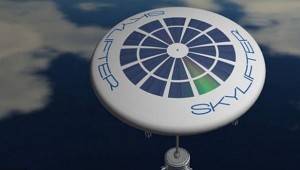Airships have received a new lease of life with the growing consciousness of environment issues. The history of airships is marred by the disastrous end to the Hindenberg zeppelin in 1937 which resulted in a lull in the research into airships as a viable transportation mode. However, in the last few decades, research and development and funding have all come together to raise the eco-friendly airship out of obscurity and to elevate it from advertising blimps to feasible and effective transportation solutions. They are already being used in various ways such as heavy lifting, research and exploration, and unmanned surveillance.

Here is a look at some of the most exciting innovations in the field of eco-friendly airships.
1. Dynalifter
This is a heavy lifting solution that combines conventional aircraft propulsion with heavier-than-air airship technology, using the lift provided by helium. With almost no ground infrastructure required, the makers of this cargo airship claim that it costs a third of conventional air transport. The prototypes tested so far suggest that it may be possible to build 1000 feet long airships built on this design that can carry up to 250 tonnes of cargo.
2. Skylifter
Another heavy lifting airship, this Australian design is a piloted dirigible balloon system that offers precision delivery of large, heavy, fragile objects in a eco-friendly manner. With its futuristic spacecraft-like design, the Skylifter is positioned as a precursor to mobile housing and luxury airship hotels. Plans are already underway to develop something along these lines that the company calls SkyPalace.
3. RAID
The Rapid Aerostat Initial Deployment system uses balloons tethered to fixed towers by thousands of meters of cables in order to provide surveillance information for defense purposes. It was initially used by the US Army in 2003 in inaccessible parts of Afghanistan, and since then has become a regular feature in defense initiative in challenging terrains such as Iraq.
4. Nephilios
This collaboration between various technical schools and universities in France is a 72-feet long carbon-neutral blimp with solar panels on its outside that generate 2.4 kilowatts of electricity to drive all of its propellers and other equipment.
5. Bullet 580
Dubbed the world’s largest airship, this design from E-Green Technologies is its first airship designed for commercial use. It is 235 feet long and takes six hours to inflate. The makers of this amazing airship claim it can carry 2,000-pound payloads to up 20,000 feet.
6. Stratocruiser
One of the earliest foray into “lifestyle zeppelins,” this concept by designers Tino Schaedler and Michael Brown is an exercise in letting imagination run wild. Positioned to offer a brief airship spa experience to people in search of unique ways of rejuvenating themselves, this design attempts to balance ecofriendliness, luxury, and nostalgia. With a doughnut hole entrance that takes you back to the early days of airship travel, this zep incorporates solar panels to fuel its power needs and uses sectional helium chambers to give it lift. Designed along the lines of a luxury hotel, the breathtaking views it will offer as it travels across the world will be complemented with standard perks like a restaurant, a spa, a swimming pool, and even a resident disc jockey.
7. Manned Cloud
Another airship concept, this whale-like design from Jean-Marie Massaud of France (developed along with ONERA, the national aerospace research body of France), has accommodation for 15 crew members and 40 guests who can undertake up to 5000 kilometers of flying over exotic locales without intruding upon or exploiting natural beauty. Of course, all standard luxury features are built into this airship.
8. Argus One
This surveillance airship combines design ingenuity with eco-friendliness to position itself as the leader in the field of green aviation. It has a segmented body, much like like earthworm, that adjusts its shape and rigidity based on aerodynamic inputs it receives from its flight environment.
9. Skycat
The Skycat airships are positioned primarily as firefighting solutions that can scoop up water from lakes and oceans, store it, transport it to the location of a fire, and release it at a controlled rate. They can also double up as passenger and cargo transport.
10. Sunship
This is a small lighter-than-air dirigible design powered by solar panels that targets long flight time for a small number (1 to 3 passengers) of people. With a targeted altitude of more than 24,000 feet, the makers claim that this airship will be able to power itself to cross the Atlantic or Pacific oceans.

 Follow
Follow